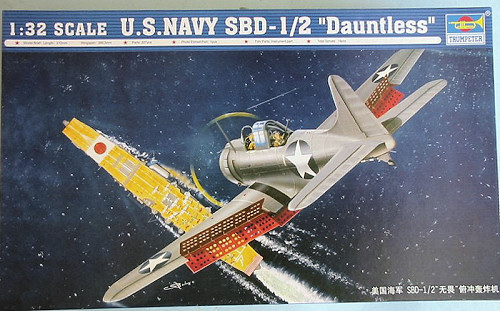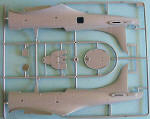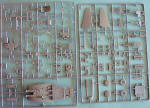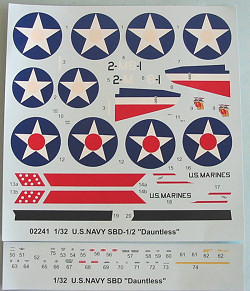
| KIT: | Trumpeter 1/32 SBD-1/2 Dauntless |
| KIT #: | 2241 |
| PRICE: | $139.95 MSRP |
| DECALS: | Two options |
| REVIEWER: | Tom Cleaver |
| NOTES: |

| HISTORY |
The Douglas Dauntless was arguably one of the most significant aircraft of the Second World War, and by far the most successful dive bomber used by any air force during that conflict. In 1942, the Dauntless was primarily responsible for blunting the power of the Japanese Navy in the Pacific War, when Dauntlesses from the "Lexington" and "Yorktown" inflicted such damage on the Japanese carriers "Shokaku" and "Zuikaku" at the Battle of the Coral Sea that these two veteran carriers were unable to participate in the upcoming Battle of Midway, where their presence might well have decisively changed history. At Midway, Dauntlesses from the "Yorktown" and "Enterprise" smashed the heart of Japanese naval aviation by sinking the "Akagi," "Kaga," "Soryu" and "Hiryu." The aircraft formed the heart of U.S. naval strike forces in all four of the carrier battles fought in 1942, as well as providing the defensive punch at Guadalcanal that kept the Tokyo Express from being able to land enough Japanese military forces to dislodge the Marines in themost decisive land battle of the Pacific War.
All of these accomplishments were the work of the SBD‑3 Dauntless, the version that went into production just before the outbreak of the Pacific War. The SBD-1, which first appeared in 1940 with a production order of 57, was an aerodynamic cleanup of the Northrop BT-1, the Navy's first all-metal monoplane dive bomber, following the acquisition of Jack Northrop's El Segundo-based company to become the El Segundo Division of Douglas Aircraft. The SBD-1 lacked armor plate or self-sealing fuel tanks, and was also too short-ranged to be used operationally aboard aircraft carriers; thus it was sent on to the Marines. This first SBD was followed by 87 SBD-2s with additional tankage and self-sealing fuel tanks. This was barely acceptable for carrier service, but nonetheless equipped VB-2 aboard the “Lexington” and VB-6 aboard the “Enterprise.” Both VB-2 and VB-6 used their SBD-2s during the first hit-and run carrier strikes in February and March, 1942. “Lexington” took most of her SBD-2s with her to the Battle of the Coral Sea in May, where all were lost when she was sunk. the SBD-2s from VB-6 were replaced by SBD-3s in mid-May; the squadron's cast-off SBD-2s, along with at least one “Lexington” survivor that had been offloaded before she sailed to meet her doom, were sent on to VMSB-241 at Midway to reinforce that unit's aging SB2U-3 Vindicators for the coming Battle of Midway.
On June 4, 1942, following the initial Japanese strike on Midway, VMSB-241's Dauntlesses and Vindicators were launched to strike the Japanese fleet. None of the Marines were really ready to go to war in the newly-arrived SBD-2s, and none were trained to make an all-out dive-bombing attack. Thus the squadron commander, Major Lofton Henderson, ordered his Marines to make shallow-angle glide-bombing attacks when they found the enemy.
Henderson was successful in leading the unit to the Japanese, where they were intercepted by the Combat Air Patrol while still some distance from the target. The Dauntlesses and Vindicators separated during this initial combat, as Lofton forged on toward the carriers. Badly hit by a defending Zero, Henderson's SBD caught fire as he entered his dive. He never pulled out. Henderson was later awarded the Medal of Honor for his leadership, and the captured airfield on Guadalcanal was named Henderson Field in his honor.
| THE KIT |
 The only other 1/32 SBDs that have previously been available were vacuforms by
Combat Models and ID Models, both of which could be termed “difficult.”
Matchbox released an SBD-5 which has some pretty severe accuracy issues.
The only other 1/32 SBDs that have previously been available were vacuforms by
Combat Models and ID Models, both of which could be termed “difficult.”
Matchbox released an SBD-5 which has some pretty severe accuracy issues.
All of these kits have now been rendered obsolete by the first kit of what will be a triumvirate - the SBD-1/2, the SBD-3/4 and the SBD-5 - from Trumpeter.
To correct the “hexperts” at That Place That Won't Be Named, this is NOT a pantograph of the Accurate Miniatures SBD kit as had been speculated. It is clear, however, that the designers at Trumpeter spent some time studying at “the feet of the master.”
 The kit comprises 227 parts on 14 sprues, with decals for the Squadron
Commander's SBD-1 of VMB-2, and for SBD-2 “White 1" of VMSB-241, which may be
the airplane flown by Lofton Henderson.
The kit comprises 227 parts on 14 sprues, with decals for the Squadron
Commander's SBD-1 of VMB-2, and for SBD-2 “White 1" of VMSB-241, which may be
the airplane flown by Lofton Henderson.
Surface detail is all engraved, which isn't right for the SBD, which has no
flush riveting past the leading edge of the wing. However, this does not
detract from the overall look. The Accurate Miniatures had no rivet detail and
no one complained. There is more detail than in the A-M kit, with a fully
complete engine, mount and accessories, with at least as much detail as the
Avenger has . The fuselage parts
for this area are clear, so a modeler could display all this detail that will be
lost when painted over.
. The fuselage parts
for this area are clear, so a modeler could display all this detail that will be
lost when painted over.
The baggage compartment and life raft compartment in the rear fuselage can be opened. The canopy can be posed open or closed, with smaller rear pieces that will fit inside each other if the option of posing open is chosen. The control surfaces are separate and are not attached with the metal things used on previous kits, but can be posed in “dynamic” positions. The surface detail is still a bit heavy, but far from what has been seen in previous releases and will look fine under a coat of paint. The perforated dive brakes have internal ribbing detail,
The cockpit is highly detailed, providing just about everything one will need, including photoetch seatbelts (without shoulder harness for the pilot, which is correct for this version of the SBD). At least one aftermarket manufacturer is already talking about producing a “detailed resin cockpit” for the kit, but in my mind this kit is in as much need of the attentions of the resin industry as was the Accurate Miniatures kit (in other words, not at all), but the resinaholics are free to spend their money as they see fit.
(I've put in images of two representative sprues so you can see the detail. Ed)
| CONCLUSIONS |
In my opinion, this is Trumpeter's best kit since the TBF Avenger, which I really liked. I look forward to putting the project on the front burner as soon as possible.
Thanks to Stevens Hobby International for the review kit.
June 2006
If you would like your product reviewed fairly and quickly by a site that has over 300,000 visitors a month, please contact me or see other details in the Note to Contributors.